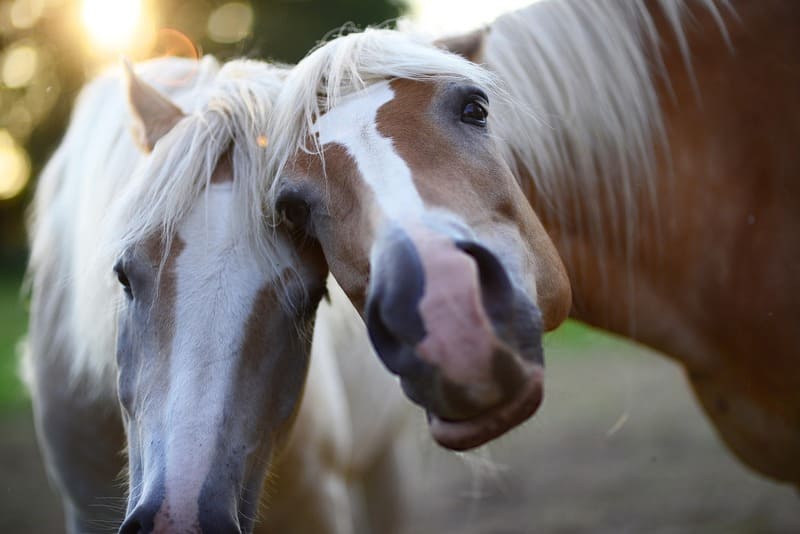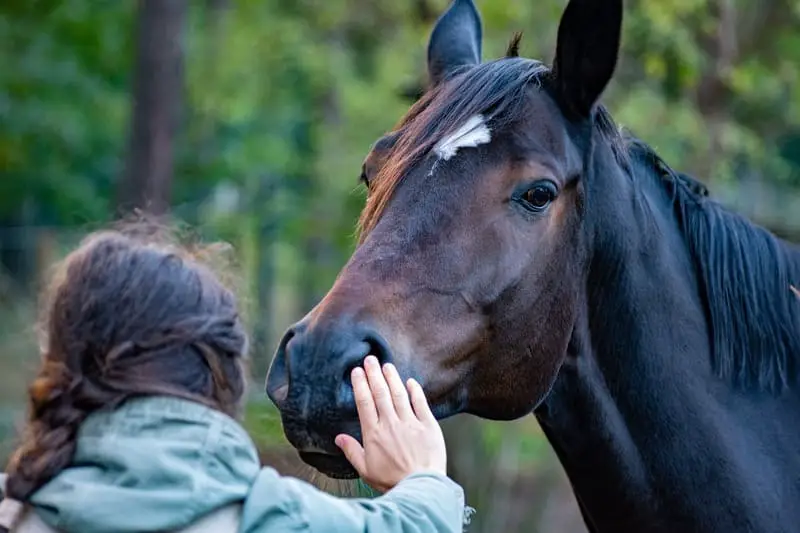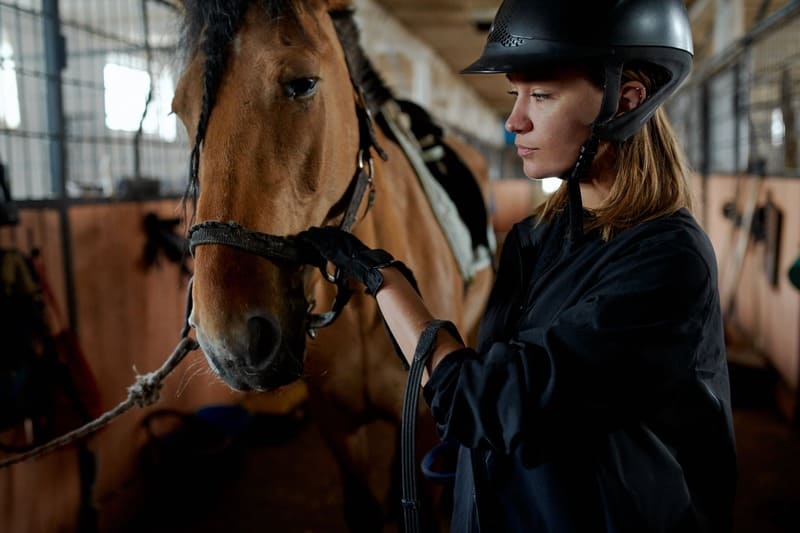Horses have been human companions for centuries, serving in various roles from transportation to sports and leisure activities. Their interactions with humans can be diverse, and one common way people engage with horses is through physical touch, including petting. But do horses actually enjoy being petted? This question requires a nuanced understanding of equine behavior, communication, and individual preferences.
In this comprehensive exploration, we will delve into the intricacies of horse-human interactions, the significance of touch in their lives, and the factors that influence whether horses enjoy being petted or not.

The Importance of Touch in Horse-Human Relationships
Before delving into the question of whether horses enjoy being petted, it’s essential to acknowledge the importance of touch in horse-human relationships. Horses are tactile animals that rely on physical interactions for various purposes, including bonding, communication, and comfort.
1. Bonding
Touch is a fundamental aspect of forming and strengthening the bond between humans and horses. When humans groom, pet, or interact with horses through touch, it can create a sense of trust and mutual understanding. This bond is crucial for various equestrian activities, from riding to training and competition.
2. Communication
Horses use touch as a means of communication with each other and with humans. They may nudge, rub, or groom each other to convey a range of messages, from seeking social connection to asserting dominance or offering comfort. Understanding these signals is essential for effective horsemanship.
3. Comfort and Relaxation
Horses often find comfort and relaxation in physical contact. Being groomed or petted by a trusted human can soothe a horse and reduce anxiety. Many horse owners incorporate grooming sessions into their daily routine to help their horses feel at ease.
Now, let’s address the question of whether horses enjoy being petted and explore the factors that influence their responses.
Factors Influencing Horses’ Responses to Petting
Horses are individuals, and their preferences for petting can vary widely. Several factors influence whether a horse enjoys being petted or may have a more neutral or negative response. It’s crucial to consider these factors when interacting with horses to ensure their well-being and comfort.
1. Individual Personality
Horses have distinct personalities. Some horses are naturally more social and affectionate, while others are more reserved. A horse’s individual disposition plays a significant role in how they respond to petting.
- Sociable Horses: Sociable horses often enjoy human interaction, including petting. They may seek out physical contact and be more receptive to grooming and petting sessions.
- Reserved Horses: Reserved horses may be less inclined to seek physical contact. They may tolerate petting but not actively seek it. It’s essential to respect their boundaries and not force interaction.
2. Past Experiences
A horse’s past experiences with human touch can greatly influence their response to petting. Horses that have positive associations with grooming and petting are more likely to enjoy these interactions, while those with negative experiences may be more cautious or resistant.
- Positive Associations: Horses that have experienced gentle, positive interactions with humans are more likely to enjoy being petted. These interactions may include grooming, scratching, and massages.
- Negative Associations: Horses that have experienced rough handling, discomfort, or pain during grooming or petting may have negative associations with touch. They may be hesitant or resistant to being petted.
3. Current Mood and Health
A horse’s current mood and physical well-being can impact their receptiveness to petting. Horses in good health and positive emotional states are more likely to enjoy physical contact.
- Stress or Discomfort: Horses experiencing stress, discomfort, or pain may not be receptive to petting. It’s crucial to assess a horse’s well-being and emotional state before attempting physical contact.
- Relaxed and Content: Horses that are relaxed, content, and in a positive emotional state are more likely to enjoy being petted. It can be a source of comfort and relaxation for them.
4. Location and Timing
The location and timing of petting can also influence a horse’s response. Some horses may have specific preferences for where and when they like to be petted.
- Sensitive Areas: Horses have varying levels of sensitivity in different areas of their bodies. Some may be more sensitive around the head and neck, while others may prefer being petted on the withers or back.
- Timing: The timing of petting is essential. Horses may be more receptive to petting after exercise, during grooming sessions, or in the evening when they are typically more relaxed.
5. Consistency and Trust
Consistency and trust in the horse-human relationship play a significant role in whether a horse enjoys being petted. Horses that trust their handlers and have consistent, positive interactions are more likely to appreciate petting.
- Trust: Trust is built over time through consistent, respectful interactions. Horses that trust their handlers are more likely to enjoy being petted.
- Positive Reinforcement: Using positive reinforcement techniques, such as rewarding a horse with treats or verbal praise during and after petting, can help create positive associations.

Signs That Horses Enjoy Being Petted
Horses that enjoy being petted often exhibit specific signs of pleasure and relaxation during the interaction. These signs can include:
- Licking and Chewing: A horse may lick and chew during or after petting, indicating relaxation and contentment.
- Drooping Lower Lip: Some horses will let their lower lip droop as a sign of relaxation and comfort.
- Yawning: Yawning can be a sign of relaxation and satisfaction during petting.
- Soft Eyes: A horse’s eyes may appear soft and relaxed, with half-closed eyelids, when they are enjoying the interaction.
- Lowered Head: A horse may lower their head when being petted, a sign of trust and relaxation.
- Purring or Nuzzling: Some horses may purr or nuzzle their handlers during petting, indicating pleasure.
It’s important to note that not all horses will display these signs, and the absence of these behaviors does not necessarily mean the horse dislikes being petted. Horses have individual ways of expressing their feelings, and it’s essential to be attuned to their specific cues.
Signs That Horses Are Neutral or Dislike Petting
Horses that are neutral or dislike petting may exhibit signs of discomfort, irritation, or resistance. These signs can include:
- Tense Body Language: A horse that tenses up, raises their head, pins their ears, or shifts their weight away from the person may be uncomfortable with petting.
- Tail Swishing: Swishing the tail can be a sign of irritation or discomfort. It’s essential to differentiate between a relaxed tail swish and an agitated one.
- Ears Back: Horses may pin their ears back or flick them back and forth when they are irritated or uncomfortable.
- Moving Away: If a horse consistently moves away from the person attempting to pet them, it may indicate a desire for personal space or discomfort.
- Pinning the Lips or Showing Teeth: Horses may pin their lips or show their teeth as a sign of irritation or discomfort.
- Kicking or Biting: Aggressive behaviors like kicking or biting are clear indications that a horse does not want to be petted.
It’s crucial to respect a horse’s cues and boundaries. If a horse displays signs of discomfort or resistance, it’s best to discontinue the petting and assess the situation to ensure the horse’s well-being.

Strategies for Positive Petting Interactions
To ensure that petting interactions with horses are positive and enjoyable for both the horse and the human, consider the following strategies:
1. Build Trust
Building trust is foundational for positive petting interactions. Spend time with the horse, engage in activities that promote trust, and establish a strong rapport before attempting prolonged petting sessions.
2. Know the Horse
Understanding the individual horse’s personality, preferences, and sensitivities is crucial. Some horses may have specific areas they enjoy being petted, while others may prefer a gentle touch around the head or neck.
3. Start Slow
If you are unsure of a horse’s preferences or their level of comfort with petting, start slowly and gently. Pay attention to the horse’s response and adjust your approach accordingly.
4. Respect Boundaries
Respect the horse’s boundaries and cues. If a horse shows signs of discomfort or resistance, discontinue the petting and give them space.
5. Positive Reinforcement
Use positive reinforcement techniques to create positive associations with petting. Reward the horse with treats or verbal praise during and after the interaction.
6. Be Attentive
Be attentive to the horse’s body language and cues. This includes both positive signs of enjoyment and signs of discomfort or irritation.
7. Grooming Sessions
Incorporate grooming sessions into your interactions with the horse. Many horses find comfort and relaxation in being groomed, and it can be an enjoyable form of physical contact.
8. Consistency
Maintain consistency in your interactions with the horse. Consistency builds trust and helps the horse feel secure in their interactions with humans.
9. Positive Environment
Create a positive and stress-free environment for petting interactions. Ensure that the horse is in a comfortable and relaxed setting.
10. Consult a Professional
If you are uncertain about a horse’s behavior or preferences, consult with a professional trainer or equine behaviorist who can provide guidance and expertise.
Conclusion
The question of whether horses enjoy being petted is not a one-size-fits-all answer. Horses are individuals with unique personalities and experiences, and their responses to petting can vary widely. Understanding the factors that influence a horse’s response, such as their personality, past experiences, and current mood, is essential for positive and respectful interactions.
Ultimately, the key to enjoyable and beneficial petting interactions with horses lies in building trust, being attuned to the horse’s cues, and respecting their boundaries. By doing so, humans can foster positive relationships with these remarkable animals and provide them with the care and companionship they deserve.
